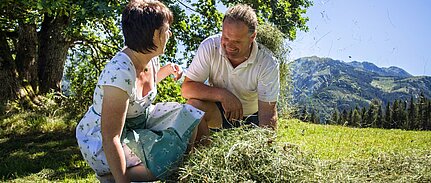And therein lies the secret of hay flowers. The sum of all these individual parts turns hay into an ancient natural medicine.
From laboratory tests we now know what we could only assume in the past: around 50 types of plants are represented in a handful of hay flowers. They contain around 1000 natural active ingredients. Such a concentrated load is otherwise difficult to find. The most important ingredients of hay flowers are the coumarins, essential oils, flavonoids and tannins.
Hay flower applications can be used on almost all parts of the body. The hay flowers have a reflective depth effect, especially wherever there are complaints where warmth is perceived as pleasant. For example, they support the treatment of lumbago, sciatica, cystitis, inflammatory and degenerative joint diseases, soft tissue rheumatism, biliary colic, stomach and intestinal cramps, nerve pain, chronic neuralgia, boils, insect bites, flatulence and coughs. The hay flowers are used in the form of packs, wraps, pads, compresses, baths or for inhalation.
We have therefore also chosen hay beds in our new room of silence. Soothing relaxation with a pleasant scent!
Hay flowers are mostly used externally. Anyone can do this at home. If your feet are tired, especially after a hike, you can take a soothing hay flower foot bath: About 4 handfuls of hay flowers are poured over 3 liters of boiling water. Cover the bath and let it steep until the water is about 26 degrees Celsius.
Then you bathe your feet in it for 15 to 20 minutes.
Take a hay flower bath to treat rheumatic complaints, joint and back pain, but also when you are exhausted and very tired:
Put 5 to 7 handfuls of hay flowers with cold water in a pot, let everything boil up and then steep for 1/2 hour. Then pour into the bath water, which should have about 37 degrees Celsius. Bathe in it for 15 to 20 minutes and enjoy. Then rest in bed for 1 hour. Such a hay flower bath also strengthens the nerves and can be used against skin impurities.
In the days of our grandmothers, a sack of hay flowers was very often put on. It can be used to combat mild stomach pain and abdominal cramps. With the hay flower sack, you put a few handfuls of hay flowers in a small linen bag and let it heat up over a pot with rising steam for about 20 minutes. The bag must not lie in the water. A steam temperature of 42 degrees Celsius is ideal. Then let the bag cool down a bit and place it on the painful area, with a dry cloth over it. Leave on for 1 hour. Ideal, for example, for bladder catarrh.
Pleasant relaxation!






